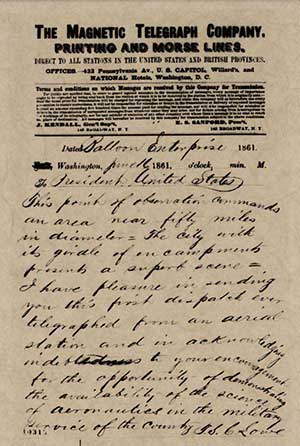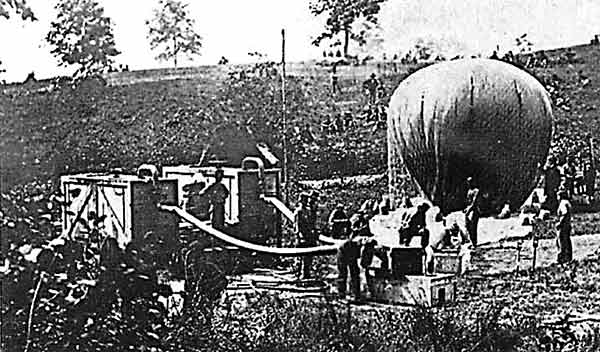
Professor Thaddeus Lowe readying the Intrepid for Flight.
Photo: Mathew Brady Photographs.
War Department. US Army.
Office of the Chief Signal Officer.
National Archives and Records Administration.
Still Picture Branch; College Park, Maryland.
The first widespread use of aerial vehicles for military purposes occurred early in the Civil War. Hot air and hydrogen-filled balloons were used for aerial reconnaissance. The use of balloons began in the North due to the persuasion of two men, Professor Thaddeus Sobieski Constantine Lowe and John LaMountain. Shortly after the Civil War began, Lowe and LaMountain separately approached the US Government communicating how valuable balloons could be in the role of reconnaissance.

Professor Thaddeus Sobieski Constantine Lowe.
Photo: Mathew Brady Photographs.
War Department. US Army.
Office of the Chief Signal Officer.
National Archives and Records Administration.
Still Picture Branch; College Park, Maryland.
The idea for balloon reconnaissance occurred to Lowe after a test flight for his anticipated attempt to cross the Atlantic Ocean in a balloon flew over Confederate territory and he was able to observe the tumult below. Upon his return to Yankee territory he contacted the sponsor for his Atlantic crossing, Murat Halstead, and persuaded him to change his support to a military balloon project. Halstead was convinced and contacted an acquaintance, Salmon P. Chase, Secretary of the US Treasury. Chase then arranged a demonstration before President Abraham Lincoln of the potential that balloons had for military purposes.

The First Aerial Telegram in History, from Professor Thaddeus
Lowe in the Balloon Enterprise to Abraham Lincoln.
Photo: Lincoln Papers.
Library of Congress Prints and Photographs Division.
Washington, D.C. USA.
Professor Lowe arrived at the capital and outlined his vision for the balloon to the president and proposed an added feature, balloon telegraphy, on 11 June, 1861. President Lincoln was interested and a demonstration was arranged for 17 June at the Columbia Armory in Washington D.C. Lowe arrived for the demonstration with his balloon the Enterprise and several representatives of the Magnetic Telegraph Company. The tethered balloon ascended to a height of 500 feet (150 metres) and the world's first telegraphic transmission from the air was relayed through wires running along the tether lines to both the War Department and the White House. The demonstration was a success and both Lowe and the Enterprise were now guests at the White House.

Professor Thaddeus Lowe Aloft in the Balloon Intrepid Observing a
Battle at Fair Oaks, Va. During the Peninsular Campaign, May-August 1862.
Photo: Mathew Brady Photographs.
War Department. US Army.
Office of the Chief Signal Officer.
National Archives and Records Administration.
Still Picture Branch; College Park, Maryland.
As a result of his successful demonstration, Lowe secured an appointment as the commander of Lincoln's newly created Balloon Corps serving under the Bureau of Topographical Engineers. Lowe was authorized to requisition equipment and personnel through the Bureau. The Balloon Corps was a civilian organization; however, and it was a low priority within the Topographical Engineers. The corps largest source of manpower was from civilian volunteers that were already balloonists. The balloonists were pioneers and lone rangers, so to speak; so the Balloon Corps soon suffered from problems caused by prima donnas with large egos and one-upmanship. These problems were exacerbated by the lack of rigid military chains of command and the activities of John LaMountain.
LaMountain, having grown tired of waiting for word from the War Department, received an invitation to demonstrate his balloon's potential from General Benjamin F. Butler, commander of the Union's forces at Monroe, Virginia. LaMountain demonstrated his balloon, the Atlantic, for General Butler and reported rebel locations in battle. This gave LaMountain the opportunity to boast that he had been the first person to use a balloon in battle, and he frequently did so in the press.

Professor Thaddeus Lowe's Balloon Gas Generators on the Capital Mall, 1861.
Photo: Department of Agriculture.
National Archives and Records Administration.
Still Picture Branch; College Park, Maryland.
LaMountain did not enjoy the benefits of the arrangement that Lowe had secured and continued to work with Butler's army. LaMountain preferred free-flight in his balloon and generally operated at greater heights. He secured a newer balloon named the Saratoga, but it was soon lost in high winds. This left him with only the Atlantic, which was nearly worn out. He hoped to secure a new balloon from Lowe, but to no avail. At this point, LaMountain was now acting as an independent entity.

Balloon Ascension, 1862.
Photo: Mathew Brady Photographs.
War Department. US Army.
Office of the Chief Signal Officer.
National Archives and Records Administration.
Still Picture Branch; College Park, Maryland.
LaMountain now assailed Lowe and the Balloon Corps in the press, self-aggrandizing and belittling everything that the Balloon Corps did at every turn. This soon became a problem for the Army that had to be solved and it caused morale problems within the Balloon Corps. After LaMountain flamed Lowe to the press in a particularly nasty exchange, the Army had had enough. After studying the problem, General George McClellan directed that LaMountain be informed that he could be of no further service to the military.
Nevertheless, too much damage had already been done to the Balloon Corps. After all of the negative press, most Army personnel did not see how the Balloon Corps could be of any use despite the great amount of useful intelligence that they had produced. Shortly, General McClellan was relieved of command in 1863. The successor appointed to oversee the Balloon Corps, Captain Cyrus Comstock, ordered cutbacks in supplies and personnel and soon cut Lowe's pay. Unable to continue with the financial constraints, Lowe resigned in April of 1863. The Balloon Corps continued a few more months, but was quietly disbanded in August.
The Balloon Corps was discontinued at about the time that it had proven unequivocally its value in battle. It had pioneered the field of military aviation and had even launched a craft from the deck of a ship on the Potomac, the USS G.W. Parke-Custis in November 1861, a precursor to the modern aircraft carrier. Other important contributions included aerial photography and cartography. Confederate forces developed their own Balloon Corps in response to the Union corps, but securing materials hampered their balloon program. Finally, Union forces succeeded in destroying the remaining Confederate balloons ending the program for the Confederacy.

10 November 1861; Professor Thaddeus Lowe ascended in his trial balloon
from the barge George Washington Parke Custis off Mattawomen Creek
to observe Confederate forces on the Virginia shore some 3 miles away.
Photo: Naval History and Heritage Command.
US Navy.
Washington Navy Yard.
Washington, D. C.
Both Union and Confederate forces tried to use balloons as unmanned aerial vehicles, or UAVs. In these experiments, unmanned balloons were loaded with explosives and then launched in hopes that they would find a target such as an arsenal and explode nearby. Since the balloons had no means of control, they were mostly unsuccessful and the idea was soon abandoned.